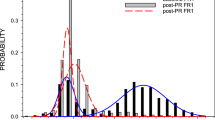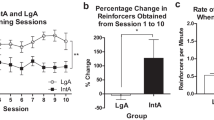Abstract
Two experiments investigated the effects of haloperidol (0.1 mg/kg) on the partial reinforcement extinction effect (PREE). In experiment 1 two groups of rats were trained to run in a straight alley using six trials/day with an intertrial interval (ITI) of 5–8 min. The continuously reinforced (CRF) group received food reward on every trial. The partially reinforced (PRF) group was rewarded on a quasi-random 50% schedule. All animals were then tested in extinction. Haloperidol was administered in a 2 × 2 design, i.e., drug-no drug in acquisition and drug-no drug in extinction. In experiment 2 two groups of rats were trained to press a lever in an operant chamber using a discrete trial procedure of ten trials/day with an ITI of 60 s. The CRF group was rewarded on each trial and the PRF group was rewarded on a quasi-random 50% schedule. Haloperidol was administered for 22 days prior to the start of the PREE procedure as well as throughout acquisition and extinction. The PREE, i.e., increased resistance to extinction of PRF as compared to CRF animals, was obtained in both experiments in all drug conditions. In both experiments haloperidol increased the rate of extinction. Experiment 1 revealed that this effect was entirely dur to the administration of the drug in extinction, independently of the drug condition in acquisition. In contrast to previous results in a one trial/day procedure, the administration of haloperidol to CRF animals did not increase resistance to extinction, failing to support the notion that neuroleptics attenuate the rewarding properties of reinforcement.
Similar content being viewed by others
References
Amsel A, Wong, PT, Traupman, KL (1971) Short-term and long-term factors in extinction and durable persistance. J Exp Psychol 90:90–95
Beninger RJ (1983) The role of dopamine in locomotor activity and learning. Brain Res Rev 6:173–196
Capaldi EJ, Berg RF, Sparling DL (1971) Trial spacing and emotionality in the rat. J Comp Physiol Psychol 76:290–299
Ettenberg A (1989) Dopamine, neuroleptics and reinforced behavior. Neurosci Biobehav Rev 13:105–111
Ettenberg A, Camp CH (1986a) Haloperidol induces a partial reinforcement extinction effect in rats: implications for a dopamine involvement in food reward. Pharmacol Biochem Behav 25:813–821
Ettenberg A, Camp CH (1986b) A partial reinforcement extinction effect in water-reinforced rats intermittently treated with haloperidol. Pharmacol Biochem Behav 25:1231–1235
Evenden JL, Robbins TW (1983) Dissociable effects ofd-amphetamine, chlordiazepoxide and alpha-flupenthixol on choice and rate measures of reinforcement in the rat. Psychopharmacology 79:180–186
Faustman WO, Fowler SC (1981) Use of operant response duration to distinguish the effects of haloperidol from non-reward. Pharmacol Biochem Behav 15:327–329
Feldon J, Weiner I (1989) The effects of amphetamine on a multitrial partial reinforcement extinction effect (PREE) in an operant chamber. Pharmacol Biochem Behav 32:65–69
Feldon J, Weiner I (1991) Amphetamine and the multi-trial partial reinforcement extinction effect (PREE) in an operant chamber: procedural modifications which lead to an attenuation of the PREE. Pharmacol Biochem Behav (in press)
Feldon J, Katz Y, Weiner I (1988) The effects of reinforce on the partial reinforcement extinction effect (PREE): implications for neuroleptic drug action on reinforcement and nonreinforcement. Psychopharmacology 95:528–533
Ferre S, Prat G, Guix T, Goma M, Jane F, Casas M (1990) T-maze performance in rats following chronic neuroleptic treatment. Pharmacol Biochem Behav 35:481–484
Gray JA (1975) Elements of a two-process theory of learning. Academic Press, London
Gray T, Wise RA (1980) Effects of pimozide on lever-pressing behavior maintained on an intermittent reinforcement schedule. Pharmacol Biochem Behav 12:931–935
Liao RM, Fowler SC (1990) Haloperidol produces within-session increments in operant responseduration in rats. Pharmacol Biochem Behav 36:199–201
Mackintosh NJ (1974) The psychology of animal learning. Academic Press, London
Mason ST, Beninger RJ, Fibiger HC, Phillips AG (1980) Pimozide-induced suppression of responding: evidence against a block of food reward. Pharmacol Biochem Behav 12:917–923
Phillips AG, Fibiger HC (1979) Decreased resistance to extinction after haloperidol: implications for the role of dopamine in reinforcement. Pharmacol Biochem Behav 10:751–760
Salamone JD (1987) The actions of neuroleptic drugs on appetitive instrumental behaviors. In: Iversen LL, Iversen SD, Snyder SH (eds) Handbook of psychopharmacology, vol 19. Plenum Press, New York, pp 575–608
Tombaugh TN, Anisman H, Tombaugh J (1980) Extinction and dopamine receptor blockade after intermittent reinforcement training: failure to observe functional equivalence. Psychopharmacology 70:19–28
Tombaugh TN, Szostak C, Mills P (1983) Failure of pimozide to disrupt the acquisition of light-dark and spatial discrimination problems. Psychopharmacology 79:161–168
Wise RA (1982) Neuroleptics and operant behavior: the anhedonia hypothesis. Behav Brain Sci 5:39–87
Wise RA, Spindler J, de Wit H, Gerber GJ (1978a) Neuroleptic-induced “anhedonia” in rats: pimozide blocks reward quality of food. Science 201:262–264
Wise RA, Spindler J, Legult L (1978b) Major attenuation of food reward with performance-sparing doses of pimozide in the rat. Can J Psychol 32:77–85
Worms P, Broekkamp CLE, Lloyd KG (1983) Behavioral effects of neuroleptics. In: Coyle JT, Enna SJ (eds) Neuroleptics: neurochemical, behavioral and clinical perspectives. Raven Press, New-York, pp 93–117
Author information
Authors and Affiliations
Rights and permissions
About this article
Cite this article
Feldon, J., Weiner, I. Effects of haloperidol on the multitrial partial reinforcement extinction effect (PREE): evidence for neuroleptic drug action on nonreinforcement but not on reinforcement. Psychopharmacology 105, 407–414 (1991). https://doi.org/10.1007/BF02244437
Received:
Revised:
Issue Date:
DOI: https://doi.org/10.1007/BF02244437




